Time to wet a line as late-summer fishing options are peaking for both marine and freshwater fish species Leave a reply
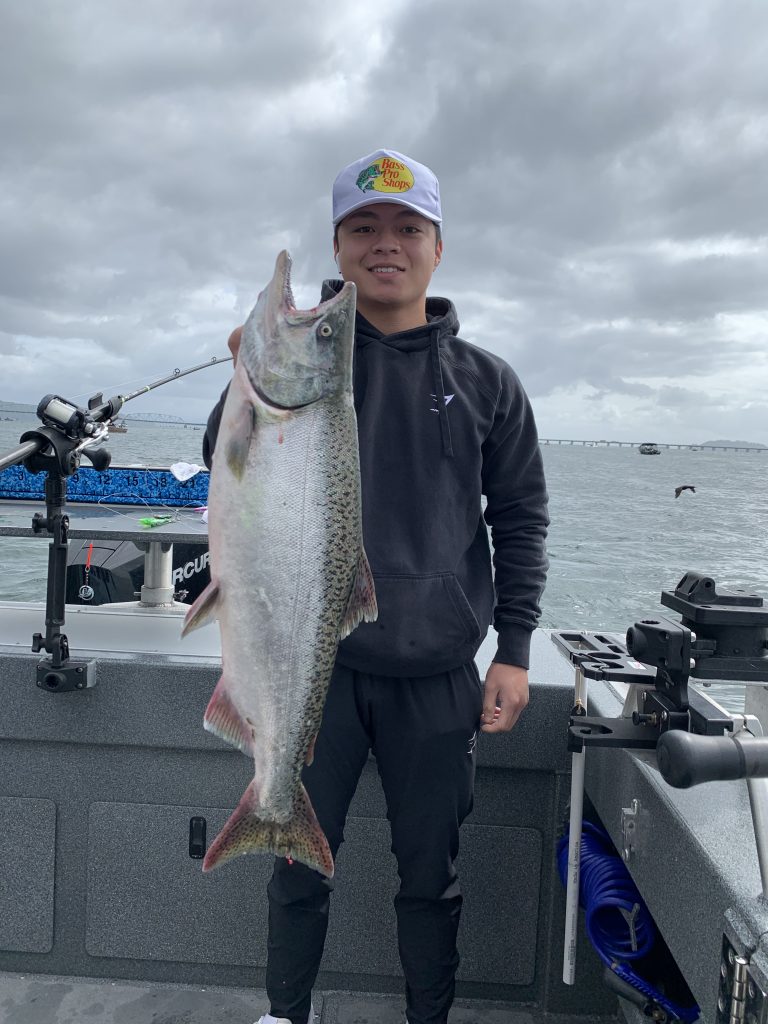
By Mark Yuasa
We’ve turned the corner on summer and are now heading into one of the busiest times for Pacific Northwest anglers although many agree the clock is working against them as fall chores or back to school duties become the priorities.
In no certain order, anglers can still point their rods toward many statewide lakes producing trout or warmwater fish species; and Puget Sound, Strait of Juan de Fuca, coastal and Columbia River for chinook, coho or pinks.
While the salmon fisheries are currently taking center stage, there’s a vast array of statewide deep-water lakes being overlooked and are the perfect places especially for those without a watercraft.
“We’ve got some lakes (around eastern Washington) in the summer that can provide a good all-around fishing experience as well as other fun outdoor activities,” said Chris Donley, the head Washington Department of Fish and Wildlife (WDFW) fishery manager in Spokane.
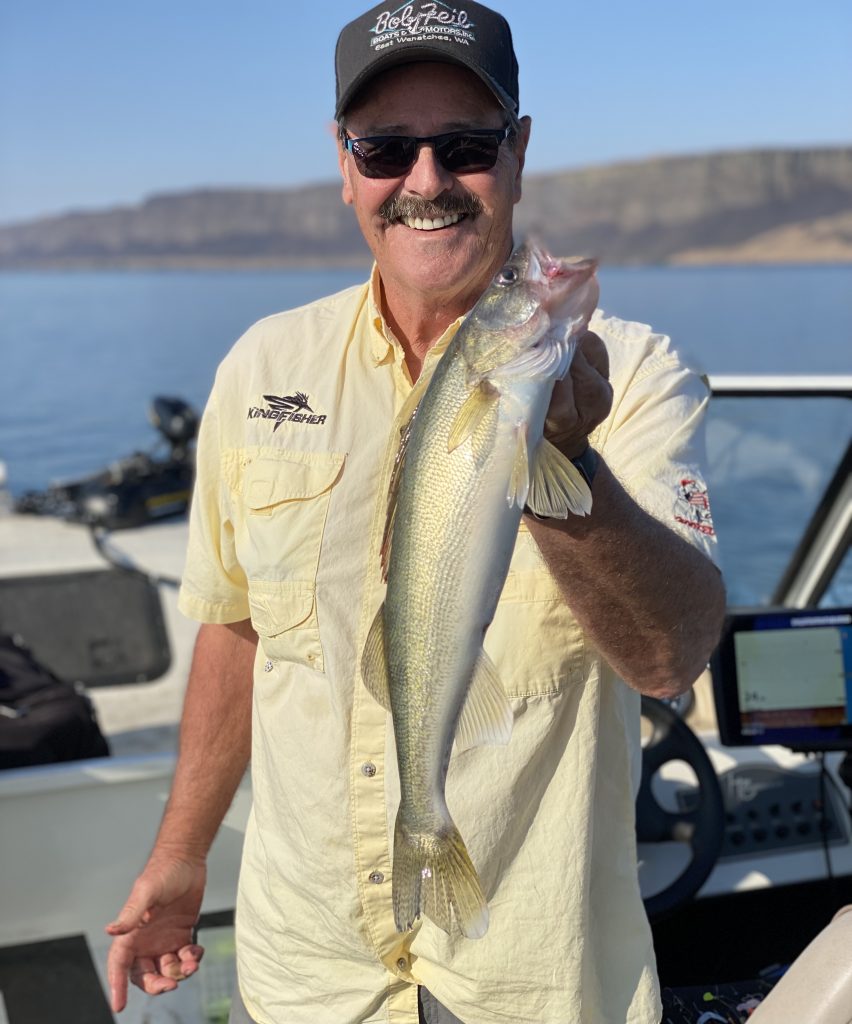
Just off I-90 bordering Adams/Lincoln counties is Sprague Lake (1,760 acres) which good for large rainbow trout (daily limit is five trout of any size), largemouth bass, catfish and bluegill sunfish. There is a great burger spot called the Viking Drive Inn (https://vikingdrivein.com/classic_american_food.html) located just a couple miles from the lake.
Rufus Woods Reservoir has great bank access for trout on the Colville Reservation, but the tribes do charge an $80 fee to fish the entire year (https://colville.nagfa.net/online/). Best fishing is by the net pens and there is RV parking and a nice camping area.
Beehive Reservoir, located eight miles southwest of Wenatchee and one mile northwest of Squilchuck State Park, covers 13 acres and is annually planted with rainbow trout that provide action throughout the summer and improves as the water cools down.
The Potholes Reservoir, located about seven miles south of Moses Lake, has a variety of warmwater fish like walleye, bass, yellow perch and walleye, plus rainbow trout. For those without a boat head to MarDon Resort that has dock with productive fishing. The resort and Medicare Beach are popular areas for trout. There is a large private resort, state park, and several developed public access areas that have all the necessary amenities.
In Douglas County, Jameson Lake is a good shoreline spot for trout although an algae bloom can put a damper on fishing during summer time and improves in early fall.
Lake Roosevelt is another worthwhile choice for a mix of rainbow trout and kokanee for bank anglers, and the Keller area seems to be a place to go. Badger Lake, located about 30 minutes south of Cheney should be good for trout. Williams Lake in Spokane County, has a resort with a large dock and as the water cools down look for the trout fishing to pick up.
Other lakes worth a try are Conconully Reservoir in Okanogan County; Fish Lake in Chelan County; and Park, Burke and Blue lakes in Grant County.
There are also many lakes in western Washington to fish with many dominated at this time of the year by excellent yellow perch fishing.
One exception is Mayfield Reservoir in Lewis County where WDFW hatchery personnel have been busy planting rainbow trout. On Aug. 22 is received 2,200 trout, plus another 4,780 on Aug. 11 and 4.
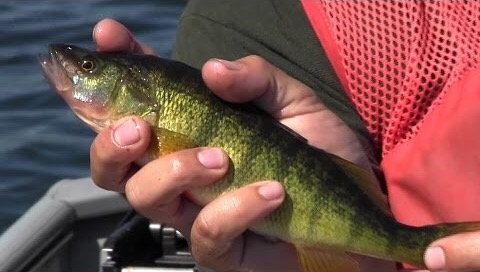
This is also prime time for yellow perch in Lake Washingtonlocated in the backyard of the Emerald City. The tasty fish are easily caught from the shore or boat, and the lake – which is 20 miles long and covers more than 22,000 acres – is excellent for yellow perch, rock bass as well as many other fish species.
Look for schools of yellow perch in shallow water, 15 to 35 feet, and close to the shoreline. They will school up in shaded locations just outside the cover of weed beds, milfoil, aquatic weeds and lily pads or under docks, piers and overhanging trees and brush.
Target Seward Park; Montlake Cut; Newport Canal; Newport Shores; Kenmore log boom and pier; Juanita Bay; Magnuson Park; Andrews Bay; Webster Point in Union Bay; Yarrow Bay in Kirkland; Gene Coulon Park in Renton; Mercer Island near Luther Burbank Park; and in South Seattle off Leschi Park, Madison Park, Stan Sayres Pits and Mount Baker Park. Lake Union around Gasworks Park are also good spots.
Other lakes to target yellow perch are Sammamish; Kapowsin; Sawyer; Goodwin; Steven; American; Angle; Desire; Meridian; Samish; Whatcom; and Bosworth.
Plenty of salmon options
Hordes of pinks – an estimated 2.9-million – have shown up in Puget Sound and the tail end of the run most likely extends beyond the Strait of Juan de Fuca with excellent catches being reported.
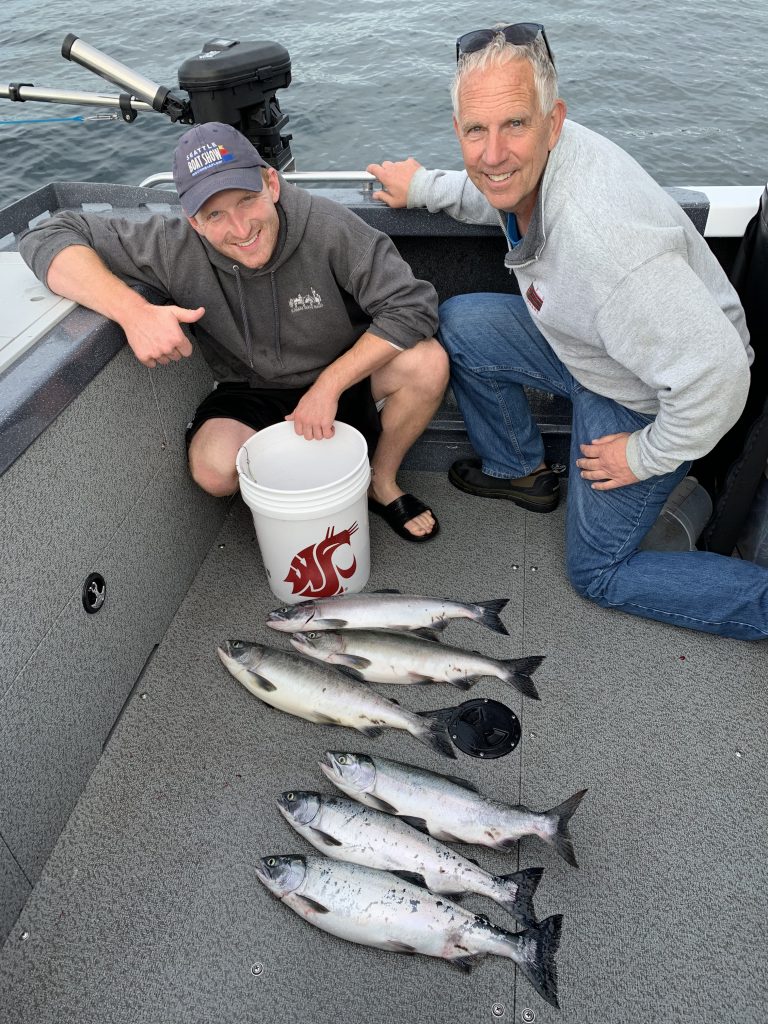
The Puget Sound pink run usually peaks in mid-August, and in southern Puget Sound the last week of August and early September are best.
When targeting pinks, the color of choice is a hot pink lure, spoon, jig or fly as the color resembles plankton or krill, which is part of their main diet.
Stick with smaller-size mini squids or small spoons tied behind a short 13- to 16-inch leader to a white colored dodger or silver flasher. Another method is a smaller 8-inch Pro-Troll flasher with a slightly longer leader of 15 to 20 inches.
From boat or shore casting a Buzz Bomb or Point Wilson type jig works and let it sink about a foot per second. Once you feel the jig go slack reel up (don’t set the jig hard because pinks have soft jawlines) until you feel the rod bend.
Other lures include a pink Rotator trailed behind a small pink plastic “hoochie” squid. Let it flutter down to the desired depth and then slowly retrieve from shore or a boat.
Keep in mind the key to success when fishing from a boat is to troll very slow (1.5 to 2.0 mph depending on current, tide and wind).
Pinks like to stay close to the shoreline to avoid strong currents making them easily accessible to bank anglers. Around an hour before and right after a flood tide or a slack tide is the optimal time to catch pinks.
Good pink spots via boat are Possession Bar, Browns Bay, off the Edmonds Marina, west side of Whidbey Island, from Mukilteo south to Shipwreck, Possession Point, Jefferson Head, Richmond Beach, West Point and Meadow Point near Shilshole Bay.
Excellent shore spots are Mukilteo Lighthouse shoreline and just north at the new ferry pier; Edmonds Pier; Lincoln Park in West Seattle; Carkeek Park; Alki Point; Deception Pass; Golden Gardens; Redondo Beach; Dash Point State Park pier and shoreline; Fort Casey, Keystone, Bush Point and Lagoon Point off the west side of Whidbey Island; Point Wilson and Fort Casey State Park near Port Townsend; Point No Point; Possession Point Bait House; Picnic Point in Edmonds; and Point Defiance Park Boathouse or Les Davis piers in Tacoma.
Those who’d like to chase hatchery kings can work areas in south-central Puget Sound (Area 11) from the north end of Vashon Island south to the Narrows Bridge. Note: Area 11 was nearing their catch quota for hatchery chinook and could possibly close for chinook retention after this Wednesday, Aug. 25.
Central Puget Sound (Area 10) is now closed for chinook retention but remains open for coho and pinks, and northern Puget Sound (Area 9) is open for hatchery coho and pinks. Southern Puget Sound is open for hatchery chinook. There are also some terminal chinook fisheries like the Tulalip Bay (open Friday to Sunday only) and Sinclair Inlet that produce action in August.
For king in Area 11, try Lincoln Park off West Seattle south to Brace Point; Dolphin Point as well as south of the Southworth Ferry Landing; Clay Banks off Point Defiance Park, Point Evans, Point Dalco off Vashon Island, entrance to Gig Harbor, Dolphin Point, Brace Point, Gibson Point and Point Fosdick, Fox Point in Hale Passage, northwest corner at the Sand Spit, Toy Point and the Concrete Dock Fox Island Fishing Pier.
WDFW is still deciding whether or not to reopen the San Juan Islands (Area 7) for pinks and hatchery coho.
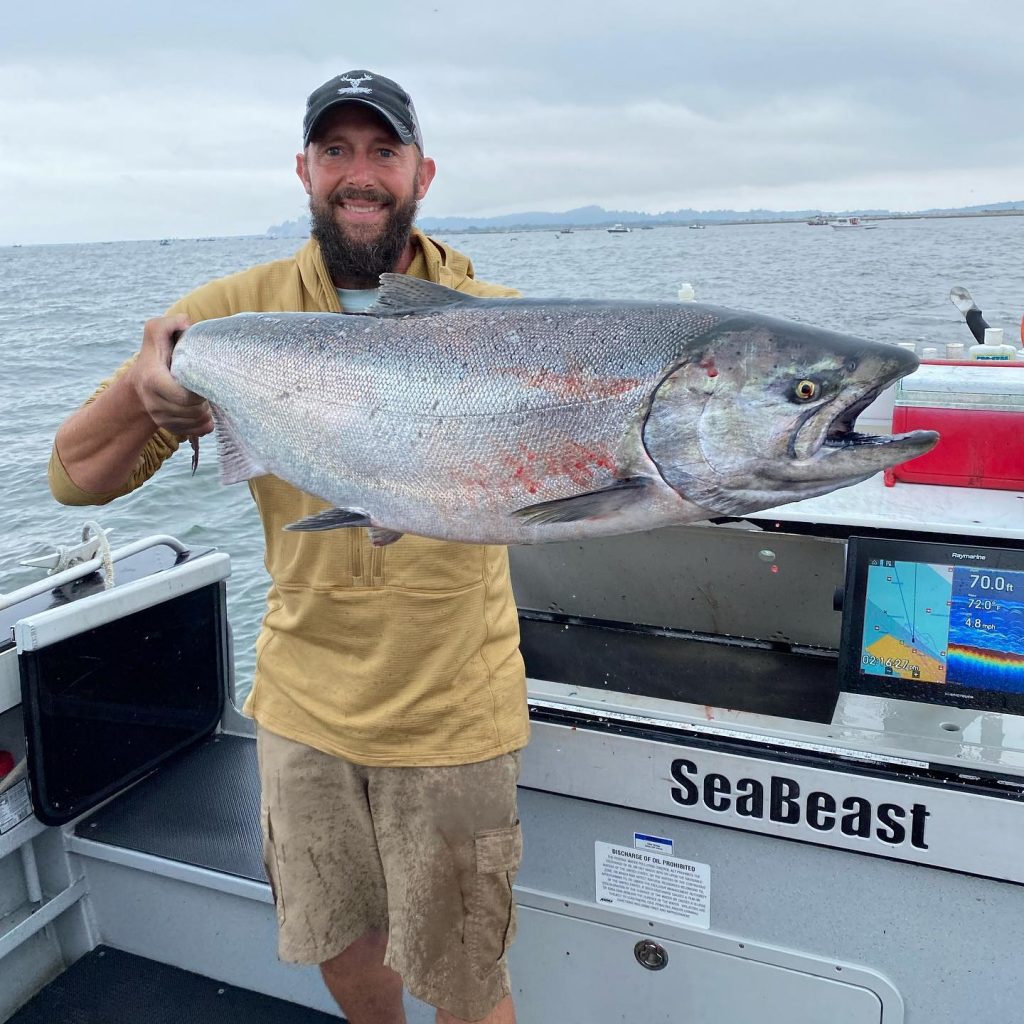
On the coast Buoy 10 on Lower Columbia River started to ramp up for coho and it’s still a viable option for kings. Don’t overlook Willapa Bay for hatchery chinook and coho, and North Bay in Grays Harbor for hatchery coho only.
In Hood Canal, Quilcene Bay is open through Aug. 31 for a coho only fishery. This is a terminal type fishery and folks have the best success tossing Buzz Bomb or Point Wilson Dart jigs.
The entire coast remains open for chinook and hatchery coho at Ilwaco, Westport, Neah Bay and La Push. Tuna chasers should also start pointing their boats offshore along the blue water line located around 30 to 50 miles offshore although fishing remains off and on.
Before heading out the door, check the WDFW website at https://wdfw.wa.gov/ to see what is open or closed and what you can or can’t keep, plus any possible emergency closures this month.
Coastal razor clam dates likely to be announced very soon
Opening dates for the coastal razor clam digging season should come to light in a little while with the first digs likely to occur in mid-September.

The Washington Department of Fish and Wildlife (WDFW) wrapped up summer assessments earlier this month and there’s a huge abundance of clams sitting under the sand from Mocrocks south to Long Beach. WDFW staff is meeting with coastal county leaders on Wednesday, and a decision could happen soon after.
Long Beach has 21.6-million recruit-size razor clams and a total allowable catch (TAC) of 8.6-million for the 2021-2022 season, which is slightly down from 24.8 million and 9.9-million respectively last season.
At Twin Harbors just south of Westport, assessments showed 8.5-million recruit-size clams (5.2-million last season) with a TAC of 3.4-million compared to 1.8-million last season. The previous record occurred in 2014-2015 season with 6.6-million recruit size clams.
At Copalis, the recruit-size clam total is 16.5-million (11.8-million last season) with a TAC of 6.6-million (recreational harvesters are allowed a share of 3.3-million) up from 4.7-million in 2020-2021.
At Mocrocks, the population isn’t a record number of recruit-size clams at 9.7-milllion down from 11.6-million last season, but still a decent population. The TAC of 3.9-million (recreational harvesters are allowed a share of 2.0-million) is down from 4.6-million last season but up from 3.3-million during 2019-2020.
The only beach that doesn’t have enough clams to support any digs in the 2021-2022 season is Kalaloch.
You don’t have to be a brain surgeon to decipher roughly when those first digs of the season will occur just by looking at the tide charts.
NOTE: These dates below ARE NOT set yet by WDFW, but will provide some insight on likely time periods of beaches opening.
Low tides: Sept. 16, minus-0.1 feet at 3:28 a.m.; Sept. 17, -0.4 at 4:30 a.m.; Sept. 18, -0.5 at 5:22 a.m.; Sept. 19, -0.6 at 6:06 a.m.; Sept. 20, -0.5 at 6:45 a.m.; Sept. 21, -0.2 at 7:21 a.m.; Oct. 5, -0.1 at 6:12 a.m.; Oct. 6, -0.3 at 7:20 p.m.; Oct. 7, -0.8 at 8:04 p.m.; Oct. 8, -1.1 at 8:49 p.m.; Oct. 9, -1.1 at 9:38 p.m.; Oct. 10, -0.8 at 10.32 p.m.; Oct. 11, -0.5 at 11:32 p.m.; Oct. 21, -0.2 at 7:57 p.m.; Oct. 22, -0.2 at 8:32 p.m.; Oct. 23, 0.0 at 9:06 p.m.
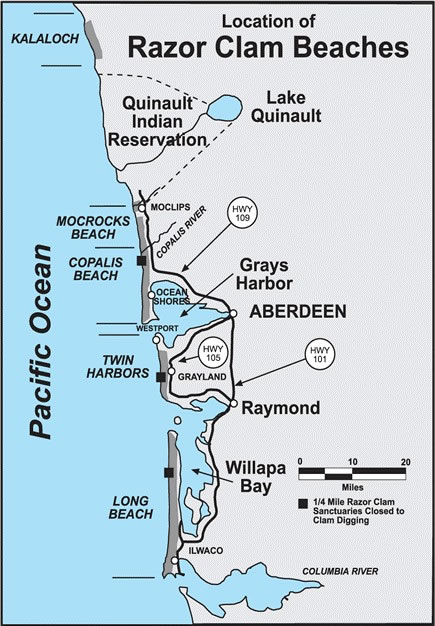
Nov. 3, -04 at 6:16 p.m.; Nov. 4, -1.1 at 7:01 p.m.; Nov. 5, -1.6 at 7:46 p.m.; Nov. 6, -1.7 at 8:33 p.m.; Nov. 7, -1.6 at 8:23 p.m.; Nov. 8, -1.2 at 9:16 p.m.; Nov. 9, -0.5 at 10:13 p.m.; Nov. 10, 0.0 at 11:16 p.m.; Nov. 16, 0.5 at 4:50 p.m.; Nov. 17, 0.1 at 5:28 p.m.; Nov. 18, -0.2 at 6:03 p.m.; Nov. 19, -0.4 at 6:36 p.m.; Nov. 20, -0.4 at 7:10 p.m.; Nov. 21, -0.2 at 7:44 p.m.; Nov. 22, 0.0 at 8:20 p.m.; Dec. 1, 0.1 at 4:09 p.m.; Dec. 2, -0.8 at 4:58 p.m.; Dec. 3, -1.5 at 5:45 p.m.; Dec. 4, -1.9 at 6:32 p.m.; Dec. 5, -2.0 at 7:20 p.m.; Dec. 6, -1.7 at 8:09 p.m.; Dec. 7, -1.3 at 8:59 p.m.; Dec. 8, -0.6 at 9:51 p.m.; Dec. 9, 0.1 at 10:45 p.m.; Dec. 16, 0.1 at 5:07 p.m.; Dec. 17, -0.2 at 5:43 p.m.; Dec. 18, -0.3 at 6:18 p.m.; Dec. 19, -0.4 at 6:52 p.m.; Dec. 20, -0.4 at 7:27 p.m.; Dec. 21, -0.3 at 8:02 p.m.; Dec. 22, -0.1 at 8:38 p.m.; Dec. 23, 0.2 at 9:16 p.m.; Dec. 29, 0.9 at 2:53 p.m.; Dec. 30, -0.1 at 3:49 p.m.; Dec. 30 -0.1 at 3:49 p.m.; Dec. 31, -0.9 at 4:42 p.m.; Jan. 1, -1.5 at 5:32 p.m.; Jan. 2, -1.8 at 6:21 p.m.; Jan. 3, -1.9 at 7:08 p.m.; Jan. 4, -1.6 at 7:54 p.m.; Jan. 5, -1.1 at 8:40 p.m.; and Jan. 6, -0.5 at 9:24 p.m.
Despite an enormous amount of digging days during the 2020-2021 season, much of them didn’t happen due to an outbreak of a marine toxin known as domoic acid – a natural toxin produced by certain types of marine algae – which can be harmful or even fatal if consumed in enough quantities.
For the moment, marine toxin levels look good and mostly in the 1 to 2 parts per million (ppm). The Department of Health Labs get test samples of razor clam from WDFW regularly, and the action level is anything above 20 ppm.
Digging during the 2020-2021 season saw a coast-wide closure from the end of October through mid-May when just Mocrocks reopened for six days of digging on May 15, 17, 24, 26, 28 and 30.
When dates are announced they will still require final approval dependent on weekly marine toxin testing. The green light is usually announced one to two weeks prior to each series of digs.
Digging could also be contingent upon continued guidance by public health officials monitoring COVID-19 in coastal communities. For more on razor clams, go to http://wdfw.wa.gov/fishing/shellfish/razorclams/.

